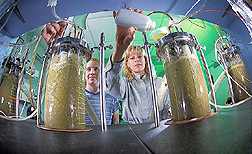This page has been archived and is being provided for reference purposes only. The page is no longer being updated, and therefore, links on the page may be invalid.
|
Read the magazine story to find out more. |
Scientists Study Benefits of Pasture Plant Diversity on Dairy ProductionBy Jan SuszkiwMarch 3, 2004 Identifying the benefits of grazing dairy cows on pasture having diverse forage plant mixtures is the objective of a cooperative study by scientists with the Agricultural Research Service and Pennsylvania State University (PSU). One interest is determining whether such pasture can tolerate heavy grazing better than pasture with only one or two forage plant species. A second interest is finding out what effect pasture plant diversity has on herd productivity and production savings to farmers who practice grass-based dairying, according to Kathy Soder, an animal scientist in the ARS Pasture Systems and Watershed Management Research Unit, University Park, Pa. Since 2001, Soder and colleagues with ARS and PSU have monitored crude protein content, dry forage yield and other features of eight pasture plots at PSU's Dairy Research Center as indicators of productivity. In the Northeast, pasture typically contains a grass species plus a legume, like clover, according to ARS agronomist Matt Sanderson. But the dairy center's plots contain various mixtures of orchard grass, white clover, red clover, chicory, perennial ryegrass, Kentucky blue grass, birdsfoot trefoil and tall fescue. Sanderson leads pasture plot evaluation, while Soder oversees the dairy cows' grazing behavior, physiology and milk production over four 21-day grazing periods. From 25 pounds of dry forage matter, plus a grain supplement, the cows produce 10 to 12 gallons of milk per day. Interestingly, their milk production on mixed pasture has differed little from control plots having two forage species. But this isn't necessarily a disadvantage, according to Soder. The main benefit expected from using mixed pasture is a greater, more persistent yield of dry forage matter that can support more cows per area than conventional pasture. Read more about the research in the March issue of Agricultural Research magazine. ARS is the U.S. Department of Agriculture's chief scientific research agency. |

